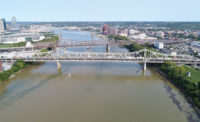Decades of inadequate investment in water infrastructure has exacerbated the economic challenges faced by water and wastewater utilities in the era of COVID-19, according to a new report released Aug. 26 by the American Society of Civil Engineers and the U.S. Water Alliance’s Value of Water Campaign.
Officials from ASCE, the U.S. Water Alliance and water/wastewater utilities speaking at n Aug. 26 briefing on the report called for more funding and policy changes to support investment, said such moves could help pull the nation out of the current recession brought on by COVID-19. “At a time when so much is at stake, we cannot continue to ignore the urgency of the situation. Communities cannot shoulder the burden capital improvements and maintaining aging water systems all by themselves,” said Radhika Fox, CEO of the U.S. Water Alliance.
According to the report, “The Economic Benefit of Investing in Water Infrastructure,” local, state and federal funding streams are meeting just a fraction of the billions needed each year to replace the nation’s water infrastructure.
In 2019, for instance, total capital spending on water infrastructure projects at local, state and federal levels was approximately $48 billion, compared to investment needs of $129 billion—an $81 billion difference. That gap is only expected to widen, the report’s authors say.
“As a nation, we have deferred the crucial investment in our vital water resources for too long, and we’re seeing the adverse results play out now,” said ASCE President K.N. Gunalan in a statement.
The situation has been made worse because of the current public health crisis. The American Water Works Association and the Association of Metropolitan Water Agencies estimate that drinking water utilities will collectively see a $13.9-billion financial loss by 2021 due to revenue and operational losses related to COVID. The National Association of Clean Water Agencies expects to see even higher losses, about $16.8 billion in 2021, including a 20% drop in sewer revenue.
ASCE and U.S. Water Alliance officials say the two challenges together present a grim picture for the U.S. economy, already reeling from a recession caused by COVID-19. The report projects that over 20 years, the cumulative water and wastewater capital investment need will rise to $3.27 trillion.
Because necessary projects have been pushed further and further into the future, aging infrastructure is starting to break down. Leaking pipes caused the loss of the equivalent of $7.6 billion worth of treated water in 2019, a loss that is projected to more than double over the next 20 years, reaching $16.7 billion in 2039. American businesses most reliant on water will spend $250 billion in 2039 on water service disruptions, according to the study.
“If this trend continues, the nation’s water systems will become less reliable, breaks and failures will become more common, vulnerabilities to disruptions will compound and public health and the nation’s economy will be put at risk,” the report authors said.
But, they added, the scenario would be very different if large investments were made to close the investment gap. Then, the national economy could stand to gain $4.5 trillion in GDP by 2039.
A $1.5 trillion infrastructure bill that includes a significant bump for water/wastewater funding passed the House 233-188 on July 1, but Senate Majority Leader Mitch McConnell (R-Ky.) has said he has no interest in bringing the bill to the Senate floor.
Rep. John Garamendi, a California Democrat who serves on the Transportation and Infrastructure Committee, said during the online briefing the bill might be stalled now with so much focus on the upcoming elections. But after the elections, he is more hopeful. “We have a major infrastructure bill in the Senate,” he said. “We need to move it.”





Post a comment to this article
Report Abusive Comment